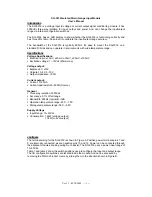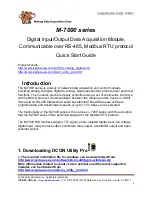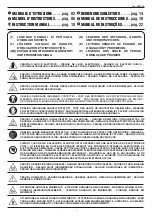
Using your MAXI MOVE
19
001
.25
06
0.E
N
re
v.
1
1
If the resident is prone to kicking off the leg clip,
the crossed attachment of the leg clips shall be
applied, which will prohibit the clip from being
kicked off (see Fig. 22).
Fig. 22
If necessary, lower the spreader bar using the
handset control, being careful not to lower it onto
the patient. If this should happen inadvertently,
there is a built-in cut-out device which will prevent
any further downward movement. Do not
continue to push the handset “jib down” button.
If the handset button is released during the lifting
or lowering procedure, powered motion will stop
immediately.
When lifting from a chair, some attendants prefer to
connect the leg straps first. This applies in
particular to patients with large thighs. In that case,
press down on the position handle on the spreader
bar and attach leg strap attachment clips. Then tilt
the spreader bar towards the shoulders to connect
the shoulder attachment clips.
Before transferring, position the patient to face
the attendant at approximately the height of a
normal chair. This provides a measure of
confidence and dignity to the patient.
Remember to release the brakes if they have
been applied, before transferring the patient.
Lift the patient using the handset control, and
adjust to a comfortable position for transfer (see
Fig. 23). The specially designed sling, together
with its integral head support, enables one person
to carry out the complete lifting function without
additional help.
Fig. 23
Move the lift away from the chair. The angle of
recline can be adjusted to increase comfort for
more restless patients. The lift can now be
directed towards the following transfer point (see
Fig. 24).
Fig. 24
When lowering the patient back down, lower the
positioning handle to put the patient into a sitting
position. This avoids further lifting strain. Take
care not to push down too quickly, as this may
jerk the patient’s head forward.
To Lift from the Bed
Before lifting a person from a bed, ensure there is
sufficient clearance underneath the bed to
accommodate the MAXI MOVE chassis legs.
Position the patient onto the sling by rolling the
patient towards you, then folding the sling in half
and placing it behind the patient’s back (see
Fig. 25).
Fig. 25
CAUTION: Always check that all the sling
attachment clips are fully in position before and
during the lifting cycle, and in tension as the
patient’s weight is gradually taken up.
Cross the leg pieces of the
sling when attaching them
to the lugs.
WARNING: Do not attempt to move the lift by
pulling or pushing on the mast, the jib, the
spreader bar or the patient as this can cause the
lift to topple over, and cause injuries. Always use
the manoeuvring handle when displacing the lift.
WARNING: When lowering the spreader bar,
ensure that the patient’s and attendant’s legs and
feet are well clear of any parts of the lift in order
to avoid patient injuries and/or damage to the
Maxi Move. Only detach the sling leg connection
clips followed by the shoulder connection clips
when the patient’s body weight is fully supported
by the bed.
















































